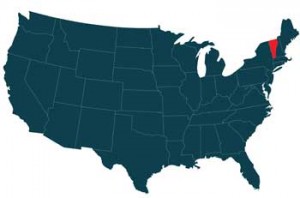Vermont Emergency Vehicle Light State Statutes
 In the state of Vermont, there are very strict laws about the types of vehicles that can display emergency lights. The color and number of the lights, the authorization of strobe lights, and the circumstances in which the emergency vehicle lights can be used, varies according to the role of the vehicle. It is important to ensure that any lights outfitted on your vehicle are permitted to be displayed according to the Vermont Motor Vehicle Laws, as detailed below.
In the state of Vermont, there are very strict laws about the types of vehicles that can display emergency lights. The color and number of the lights, the authorization of strobe lights, and the circumstances in which the emergency vehicle lights can be used, varies according to the role of the vehicle. It is important to ensure that any lights outfitted on your vehicle are permitted to be displayed according to the Vermont Motor Vehicle Laws, as detailed below.
Police Lights
Under Vermont State Law regarding motor vehicle operation, police vehicles are allowed to display blue and white lights. According to state statute 23 V.S.A. § 1252, section A1, all law enforcement vehicles owned or leased by a law enforcement agency are permitted to display lights in blue and white. Additionally, certified law enforcement officers or members of the Vermont Criminal Justice Training Council are allowed to equip their vehicles with blue and white lights.
The same section permits a town constable to apply for blue and white emergency lights for their personal vehicle. The application is required to be accompanied by a certification from the town clerk that the applicant has in fact been appointed to the position of constable. The clerk also must attest that the constable's authority to participate in enforcement activities has not been voted down by the town. The constable must also have passed a basic training course and complete yearly in service training in order to obtain and maintain the police light permit. More information about the application process is detailed in the section titled "Permits" below.
Section A6 of the same law also allows for blue or a blue and white combination of emergency lights lamps to be displayed on restored law enforcement vehicles that are used for exhibition purposes, such as in a car show or a parade. The lights on these vehicles are only allowed to be activated when participating in the exhibition.
Per Vermont state statute 23 V.S.A. § 1015, sections A and B, law enforcement vehicles are permitted to engage their emergency lights and disregard some traffic laws when pursuing a person suspected of breaking the law. These vehicles are also permitted to activate their lights and go faster than the maximum speed limit and go through stop signs and red traffic signals when responding to an emergency.
Fire Truck Lights
According to Vermont state statute 23 V.S.A. § 1252, section A2, all vehicle owned by the town fire department are permitted to display red or red and white signal lights. These vehicles are not required to have a permit to be outfitted with the emergency lights.
Similar to restored law enforcement vehicles, section A6 of this same statute allows restored fire vehicles to display red lights, or a combination of red and white lights. These vehicles are also only permitted to activate their lights during exhibition events.
Fire trucks are allowed to activate their lights when responding to a fire emergency per Vermont state statute 23 V.S.A. § 1015, sections A and B. This statute also allows for fire vehicles to go faster than the speed limit, drive the wrong way on roads when necessary, and to go through red lights and stop signs after first slowing down. Fire vehicles are not allowed to engage their fire truck lights when returning to the fire station after the emergency has passed.
Volunteer Fire Fighter Lights
Red or red and white emergency lights are also authorized for volunteer fire fighter vehicles. According to state statute 23 V.S.A. § 1252, section A2, volunteer firefighters and rescue squad members can apply to utilize these emergency lights on their personal vehicles. These volunteers are also permitted to apply to put emergency vehicle lights on an employer's vehicle when the volunteer has written authorization from the employer to utilize the vehicle for fire and rescue emergencies. More information on the application process is explained in the "Permits" section below.
Vermont state statute 23 V.S.A. § 1015, sections A and B, permits a volunteer fire vehicle responding to an fire alarm to activate the emergency lights. The vehicle may also disregard speed limits and stop signals after first slowing to ensure there will not be a collision. Volunteer fire vehicles are not permitted to use their lights when returning from a fire call.
Ambulance Lights
Similar to fire trucks and volunteer fire vehicles, ambulances are also authorized to use red or red and white emergency lights, per Vermont State Statute 23 V.S.A. § 1252, section A2. These vehicles are not required to apply for a permit.
According to statute 23 V.S.A. § 1015, sections A and B, an ambulance responding to an emergency call is permitted to engage the emergency lights and pass through a red stop signal or stop sign after first slowing down. The ambulance also may exceed the speed limit and disregard the directionality of the roads.
Tow Truck Lights
Tow trucks are permitted to display amber lights per Vermont state statute 23 V.S.A. § 1252, section B. Wreckers must mount their lights so that they are visible on all sides of the vehicle. Tow trucks are not permitted to have a siren installed with the lights. A permit is not required in Vermont to display amber lights.
Construction Vehicle Lights
According to state statute 23 V.S.A. § 1252, section B, road maintenance vehicles such as construction trucks are authorized to display amber emergency lights. Like tow trucks, the lights should be mounted so that they can be seen from all sides of the vehicle. Additionally, these vehicles are not authorized to be outfitted with a siren, and do not require a permit to install the amber lights.
Utility Vehicle Lights
 Service vehicles such as utility trucks can display and utilize amber lights per Vermont state statute 23 V.S.A. § 1252, section B. The lights must be mounted high atop the truck so that they are clearly seen from 360 degrees around the vehicle. There is no permit required to display lights on service vehicles. Sirens are not allowed to be outfitted on utility vehicles.
Service vehicles such as utility trucks can display and utilize amber lights per Vermont state statute 23 V.S.A. § 1252, section B. The lights must be mounted high atop the truck so that they are clearly seen from 360 degrees around the vehicle. There is no permit required to display lights on service vehicles. Sirens are not allowed to be outfitted on utility vehicles.
Pilot Vehicle Light
Referred to as escort vehicles per the Vermont Department of Motor Vehicles, pilot vehicles are required to accompany oversized loads that meet or exceed 12 feet wide, 80 feet long, or have a 15 foot overhang. The pilot car must be outfitted with a flashing amber light at the highest point of the vehicle, and must be visible from 360 degrees. Additionally, the escort vehicle must leave its headlights on the low beam setting for the duration of each move. The escort vehicles are also required to display a sign on the front reading “OVERSIZE LOAD” when leading, or mount the sign on the rear when following the truck. The oversized load requires a permit, but the accompanying escort vehicle does no need to be separately supplied with a permit to utilize the amber lights.
Security Vehicle Lights
There are currently no state statutes or any regulations through the Department of Motor Vehicles in the state of Vermont regarding emergency lights on security vehicles.
Permits
Personal vehicles that require a permit to display red or blue emergency lights can access the application through the Vermont Department of Motor Vehicles. Once a permit has been granted, it must be carried in an accessible location while operating the vehicle and shown to any law enforcement or inspection personnel, as one would with a driver's license. The permits for emergency lights are specific to the vehicle for which they are authorized; if the registration is transferred to a different vehicle, a new permit application must be submitted within 30 days.
The use of emergency vehicle lights are strictly regulated in the state of Vermont. The color of the light, permission to utilize strobe lights, and circumstances when the lights can be activated are all clearly delineated in the motor vehicle statutes for the state. It is important to pay close attention and adhere to the laws governing emergency lights, and to apply for the appropriate permits when necessary.
For more information about what lights may be available to you, we suggest calling your State Highway Patrol office at: 802-241-5000
*Please note that these numbers are what we are currently able to find and the numbers may have changed since this listing.
Disclaimer: The emergency vehicle light state statute guide was created by Extreme Tactical Dynamics as a guide and reference. We make no claim to the accuracy or validity of this guide. This guide was written to the best of our knowledge and has been provided to our customers as a courtesy ONLY! The information in this guide is our interpretation of the law as we have read it. We cannot be held responsible for any errors as this is only our interpretation of the law and the laws are constantly changing. We cannot be held liable or responsible for any errors and recommend that our customers refer to their local authorities to confirm the particular statue that governs their use of emergency vehicle lights.
 Facebook
Twitter
Google+
Instagram
YouTube
Facebook
Twitter
Google+
Instagram
YouTube


